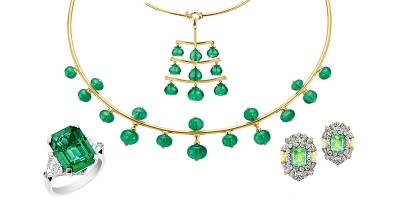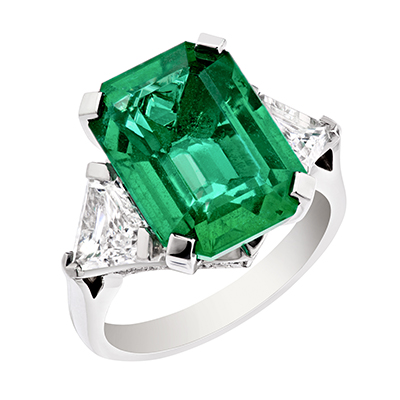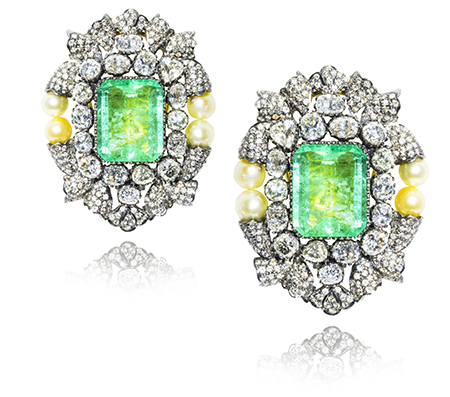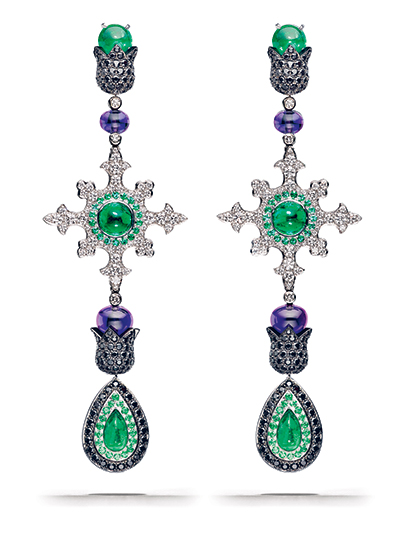Green stones are all the rage — tsavorites, tourmalines, peridots and jade have all soared in popularity and price recently. Yet emeralds, with their uniquely rich, deep shade, are the undisputed queens of green. Prized by the Egyptians — Cleopatra had emeralds carved with her image — they were sacred to the indigenous people of Peru and Colombia and helped Spain build the wealth of its South American empire. They became an obsession of India’s 17th-century Mughal rulers. Valued in the Middle East due to green’s symbolism in Islam, emeralds were admired in the west for their beauty.
Green giants: Emerald's coming of age
8th March 2016
Coveted by everyone from Cleopatra to the maharajas of India, emeralds have been in demand since time immemorial—and 2016 is turning out to be a big year for the precious stones
Emeralds are one of the classic precious stones usually mounted with diamonds. Their popularity grew in the early 20th century, when the historic jewellery of the maharajas began to influence the style of great European houses such as Cartier and Boucheron, whose clients had included these potentates. More recently, the TV documentary The Million Pound Necklace, following the creation of an emerald necklace by British jeweller Boodles, highlighted the allure of these stones.
Events this year are bringing this more sharply into focus. In March, pieces from several jewellers using stones from the Muzo mine in Colombia, a rich source of the finest emeralds for hundreds of years, were launched at the Baselworld trade fair in Switzerland. In July, Parisian jeweller Van Cleef & Arpels, known for its feminine designs and exquisite workmanship, will unveil Émeraude en Majesté, a 60-plus-piece collection of emeralds, some mixed with diamonds and other precious stones and set in a variety of metal colours.
The media coverage for this new high jewellery collection will likely push emeralds further into the spotlight. As Van Cleef & Arpels’ CEO Nicolas Bos says, most of us know emeralds as intensely green and in a rectangular cut — considered the best way to safeguard a strong but brittle gem and show off its deep light — but they are far more varied. “We wanted to do a mono-gem collection and emeralds offer the greatest diversity within one colour spectrum,” he says. “In terms of cut, apart from the traditional rectangle, there are pear shapes, smooth cabochons, sugarloaves, old cuts no longer used and antique carved stones.” There is also, he says, a great diversity of colour: “Colombian stones are often seen as the deepest and most typical, but many others are as beautiful in their own way. We have wonderful stones with a bluer tint from Zambia; extraordinarily attractive, paler-green gems from historic Panjshir in Afghanistan, which are still being mined, despite all the difficulties there; and emeralds from Russia so pale they are almost like aquamarines, but very lively and not so expensive.”
Most of us know emeralds as intensely green and in a rectangular cut, considered the best way to show off the gems’ deep light, but they are far more varied and offer a great diversity of colour
Five years in the planning, the collection draws on stones already in the house archive and new ones matched to them. “I know some people believe a Colombian old-mine stone is the only emerald worth having, but what is more important is choosing the right stone for the design you are creating,” says Bos. “Maybe that calls for a paler stone. What is important for us is that it should be the best example of the type we have chosen.” Other jewellers working with emeralds also use colours across the spectrum. You can find deep Colombian colour, mixed with purple amethysts and black spinels, in Giampiero Bodino’s Rosa dei Venti pieces, while Pippa Small works with antique Mughal emeralds from ancient Egypt and beautiful, light Panjshir emeralds. Her jewellery supports the Turquoise Mountain charity in Afghanistan; an intricate necklace made through the project is now on show at the Smithsonian Museum in Washington. More simply, Georg Jensen has launched a classic Scandi gold neckpiece modernised with a beautiful pendant of Zambian emerald drops, while Fabergé has set standout Zambian emeralds in sparkling diamonds and added them to the dial of a stunning watch.
The launch of the Muzo stones at Baselworld is significant because it marks a fresh chapter for Colombian production. New emeralds from the country have become rare, due to the slump in production amid political and security difficulties in the country. Emeralds from other countries — especially Zambia, where Gemfields’ Kagem mine is a model for socially responsible mining — have been taking over with a modern clientele that increasingly cares about traceability and ethics.
Importantly, the Muzo emeralds at Baselworld were mined using sustainable, ethical methods and state-of-the-art techniques. Muzo — named after the tribe whose lands surrounded the mine and who fiercely resisted the Spanish for many years — is the most famous Colombian mine and has produced some of the world’s most historic stones. These include those intended for the Spanish crown in an emerald-studded orb and cross, which disappeared after a ship foundered in a hurricane in 1622; they were only salvaged a few years ago.For many years, Muzo was partly owned by gem strongman Víctor Carranza. He worked closely with the Colombian government, but his methods were hardly transparent. The new American investors, Minería Texas Colombia, bought his share before he died and closed down sales for two years to introduce modern mining methods and social support and to ensure that stones coming to market would be “clean”.
According to Jason Woods, head of sales and marketing for the company, it is not only a question of supply and demand, but also of responsibility. “We want the consumer to feel comfortable with buying a Colombian emerald, to be sure it is above board,” he says.
It is great to have ethical people care about this. The old-mine stones still have a magic that makes them top for investment
Production is increasing with new machinery allowing the firm to access areas that hand tools cannot, although picks are still needed for the delicate work of uncovering emeralds in the thin, white calcite veins. Like any mine, Muzo produces many lesser-quality gems, but these have important uses — as pavé or as milky, paler feature stones.
Designers’ responses to the new stones have been favourable. Shaun Leane has designed a fluid, impressionistic suite based on an octopus to showcase the Muzo stones, including big cabochons and small pavé. “These stones seem to have an internal light that creates an ethereal green glow and reminds me of rich, luminous colour deep beneath the sea,” he says. “The cabochons have a unique, pool-like depth that led the design process.”
For Sameer Lilani of Amrapali, “it is great to have ethical Colombian stones. People really care about this and Gemfields’ ethical stance has helped make Zambian stones successful. But old-mine Colombian stones still have a magic that makes them the top for investment.”
Whether prices rise in general remains to be seen. “The arrival of top-quality, traceable Colombian stones will elevate the market, but more at all levels makes it more democratic,” says Jason Woods. “We like to think of this as emeralds for everyone.”
The launch of the Muzo stones at Baselworld is significant because it marks a fresh chapter for Colombian production. New emeralds from the country have become rare, due to the slump in production amid political show off the gems’ deep light, but they are far more varied and offer a great diversity of colour”










